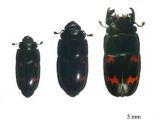Do you think that only the big hunks get some humping action? In fact, it is all about strategy adapted to the size, as revealed by a new research published in the journal "Ecological Entomology."
In the beetle world, the large males are those winning a direct fight for the mating game, as their large jaws exclude any smaller rival from the competition. But the battle is not lost by the smaller males. In male sap beetles (Librodor japonicus), no matter if large, medium or small, anyone gets a chance to father, as found by the team led by evolutionary ecologist Takahisa Miyatake at Okayama University, in Japan.
These beetles are common in Japan and feed on the sap exuded by oak trees. The largest males wait for females at feeding areas (in the lab, the feeding areas were represented by thin banana slices) and then combat for the mating right.
Medium-sized males have no chance to beat larger males, that's why it appears they have developed relatively larger wings than other males, which enables them to fly longer searching for still unoccupied feeding sites, where they get a chance for rolling in the hay.
But the smallest males act completely different: they have huge testicles. They remain at feeding sites with big males and then sneakily try to mate with females when the larger males finished their job: their huge sperm amounts can outcompete that of the larger males in the female's genital ducts. Scientists had known about this tactic before, but not that the middle-sized males use it as well.
"Researchers should reexamine other beetles for such strategies as well," said Miyatake.
Other research made in 2007 on seed beetles (Stator limbatus), at the University of Kentucky, showed that smaller males took off faster and got to the females faster than larger rivals, presumably allowing them to mate more quickly and more often.
Other examples of smaller males being in advantage in the sex race are seen in shorebirds, where the birds compete with acrobatic flights, and smaller males are favored as they can turn faster in displays. These findings could help explain why males in various cases of insects are smaller than females.
Smaller males are greatly advantaged in their race towards the females at cooler temperatures, as they warm up faster, because there is less weight for their bodies to heat up, allowing faster takeoffs.

 14 DAY TRIAL //
14 DAY TRIAL // 
